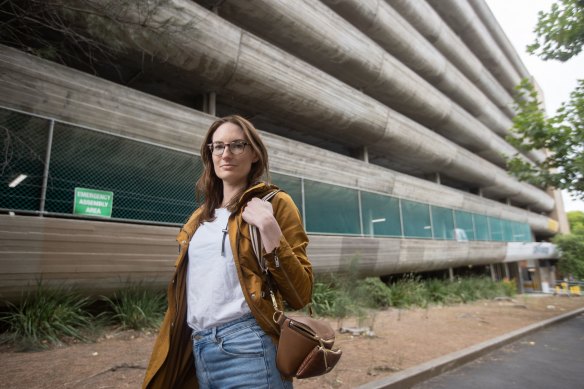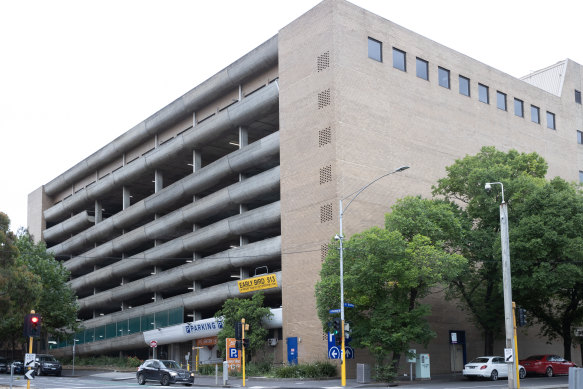By Cara Waters
A brutalist 1970s car park in Carlton is being heritage listed, but the City of Melbourne has left the door open for its future demolition.
The council voted unanimously on Tuesday night to adopt the Carlton Heritage Review, which included the car park, on the corner of Grattan and Cardigan streets, due to its local aesthetic significance and representative value.

Local resident Katie Roberts-Hull spoke at the council meeting on Tuesday night opposing the heritage protection of the Cardigan House car park. Credit: Simon Schluter
But councillors said the design of the seven-storey concrete car park with its sloping floors and low ceilings made it difficult to adapt for alternative uses, so the car park could still be demolished despite the heritage listing.
“The heritage overlay does not necessarily mean a prohibition on demolition,” Councillor Jamal Hakim told the meeting. “Including the car park in the planning scheme amendment... does not preclude development on the site in the future that can be considered.”
The car park was designed by architecture firm Mockridge Stahle & Mitchell and built in 1974. For many years, it was the Royal Women’s Hospital car park until the hospital moved to Parkville.
It was one of 24 new places that the Carlton Heritage Review recommended be covered by the heritage overlay.
The independent Planning Panels Victoria’s report into the Carlton Heritage Review, delivered in November last year, found the car park was “striking, robust and bold” and it was highlighted as an important example of brutalist architecture.
Brutalism is a style of architecture developed in the 20th century, characterised by minimalist constructions showcasing bare building materials and structural elements over decorative design.
Several residents made submissions at the council meeting opposing the car park’s inclusion in the Carlton Heritage Review, including Katie Roberts-Hull, who called for the car park site to be used to build more housing.

Cardigan House car park in Carlton was heritage listed by the City of Melbourne on Tuesday night. Credit: Simon Schluter
Roberts-Hull said the local community had no interest in protecting the car park and the heritage listing was purely driven by the external private consultants hired to conduct the Carlton Heritage Review.
“This is symbolic of how heritage has gone too far,” she said in her submission to the council. “Protecting a car park is like protecting a cigarette factory. It creates more pollution in the area, obviously more traffic and is a symbol of car dependency in a suburb where you don’t really need a car at all.”
Roberts-Hull said the opportunity costs for the huge well-located site were immense with her daughter’s daycare located across the road on the former site of the demolished Royal Women’s Hospital.
“I’m grateful the hospital did not have any heritage protection and was allowed to be replaced by a development that has enhanced our community,” she said.
“The potential benefit of protecting the car park is for a small number of architecture enthusiasts, but this is outweighed by the harm caused to the community.”
However, acting lord mayor Nicholas Reece told The Age that the inclusion of the car park in the heritage listing reflected expert opinion that it was a distinctive building with architectural significance and there was value in it being retained as an example of a particular era of built form in Melbourne.
“Just because a building receives heritage listing does not mean it cannot be redeveloped or even demolished,” he said.
“It does mean that any alterations to the building will be held to a higher standard, but we have seen many examples of heritage buildings across the city which have been significantly redeveloped notwithstanding their heritage status.”
The Morning Edition newsletter is our guide to the day’s most important and interesting stories, analysis and insights. Sign up here.